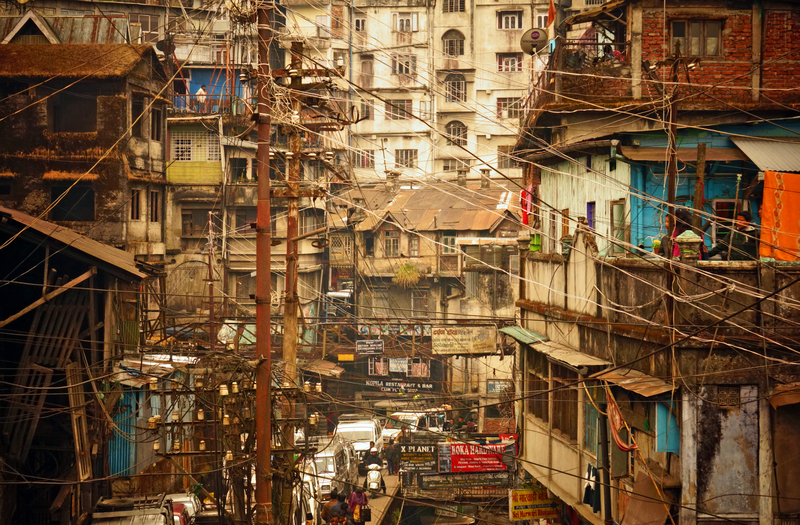
In India’s fast-growing economy, a booming electricity demand regularly exceeds the supply of generated power—a challenge for the country’s small businesses. Credit: Kiramogilenskikh|Dreamstime.com.
Concerns about U.S. power outages due to extreme weather events have been mounting but pale in comparison to India: Its electricity supply has not kept up with its fast-paced economic growth, and the demand of households and firms regularly exceeds the amount of generated power.
The largest blackout in India’s modern history affected 600 million people in July 2012. Rural households faced 11 hours of average daily outages in 2015, and one of the world’s fastest-growing markets for air conditioners contributes to the skyrocketing use of electricity in urban areas.
To understand what such power shortages mean for India’s small-business sector, AAE professor Corbett Grainger and PhD student Danjing Lei teamed up with World Bank economist Fan Zhang.
“A 2016 study found moderate effects of power outages on the productivity of large manufacturing firms with at least 100 employees,” says Grainger. “The goal of our study—the first analysis of small-firm data from multiple time points—was to estimate the historical impact of outages on capital-constrained firms without backup power sources.”
The Census of Ministry of Micro, Small and Medium Enterprises (MSMEs) provided data on sales revenue, operating costs, net profit, industry sector, urban or rural location and employee numbers for more than 1.3 million firms with fewer than 50 workers in two fiscal years (2005-2007). Three-quarters were manufacturing firms; the rest represented repair/maintenance and service sectors. MSMEs employed more than a third of India’s workforce during the study period.
The team combined the firm data with annual weather and power shortage data for 36 states and territories. The Indian government provides state-level estimates of power shortages as the percent of unmet demand. Each month, energy analysts estimate the theoretical amount of electricity that would have been demanded at that month’s prices if supply had been unlimited and compare this number with the amount of generated electricity. At the end of the year, the monthly estimates are combined into an annual energy deficit measure.
On average, small firms experienced shortages 14% of the time, meaning they were without electricity during 14% of their annual operating hours. This number ranged from 5% to 33% across the 36 states and territories.
To accurately estimate the causal effect of shortages on firm productivity, the analysis model accounted for the fact that more productive firms with a higher electricity demand contributed more to their state’s energy deficit. The results showed that the average outage level during the study period caused a 1.5% decrease in firm profit.
“We expected a negative effect for small firms but were surprised that its magnitude was similar to large firms in the 2016 study,” says Grainger. “However, we also saw evidence that small firms adjust to regular power outages differently than large firms.”
Almost half of the large firms used capital investments as an adjustment mechanism: They purchased backup generators to remain productive, even though self-generated electricity was more expensive than grid electricity.

Such purchases are infeasible for small firms with fewer savings and no access to bank credits or loans. Instead, some firms responded with labor substitution. For example, employees of small-scale garment production firms can still cut fabric, assemble pieces and use manual sewing while electric sewing machines are unavailable. In this case, power shortages may have minimal effects on firm output.
The researchers found that power shortages caused a greater reduction in productivity for urban than rural firms, in part because India had not yet reached its rural electrification goal by 2007. In villages with access to electricity, small firms with a variety of work tasks were likely more flexible in dealing with power interruptions. Urban areas had a higher proportion of specialized sectors that relied heavily on electricity. For example, replacing electric with non-electric tools is more difficult in furniture-making and the repair of cars and household appliances.
Power shortages remain a common problem for both households and the MSME sector, which employs 110 million people and contributes significantly to the country’s economic growth and poverty alleviation. To support the adoption of technology in small businesses, uninterrupted access to electricity is essential. Since India’s government has committed to a net zero goal by 2070, grid modernization efforts should include both the integration of renewable energy sources and more reliable distribution systems, says Grainger.
“Some economists have argued that India’s electricity is underpriced, meaning that demand is higher than it would be if consumers were paying the actual cost,” he adds. “Restructured rate models that give utilities the financial ability to improve their generation and distribution capacity would be better than more firms using ‘dirty’ diesel or gas-powered generators to produce their own electricity, which is not compatible with India’s net zero goal.”